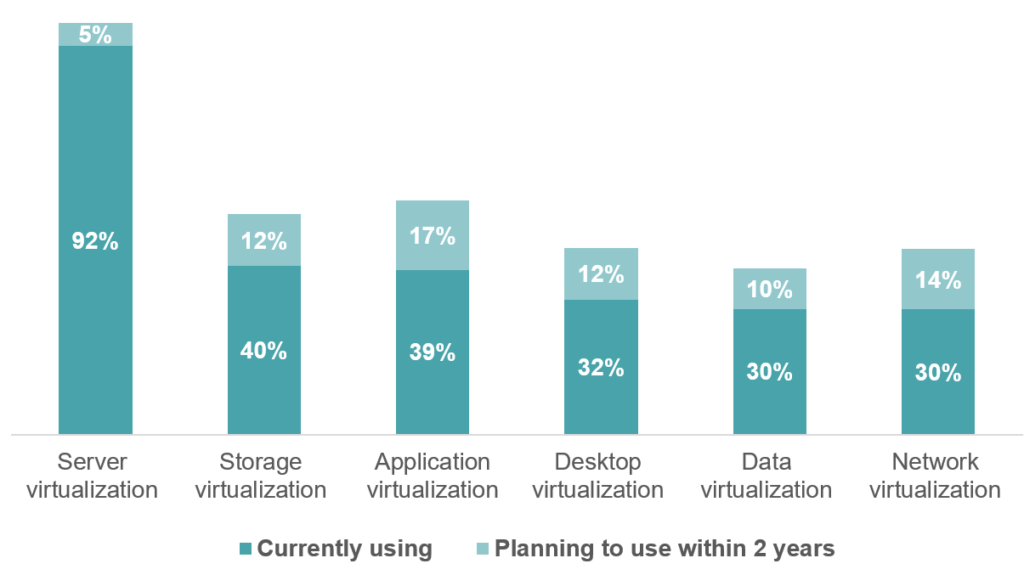In working with several different organizations, I’ve seen a broader conversation begin to happen around technology. Business and IT leaders alike ask better questions, forecast IT budgets for their organizations, and are less afraid to try out new technologies.
When it comes to cloud and virtualization, we’ve hit a certain maturity in the market. Specifically, organizations are now better suited to understand what should be on-premise and what should live in the cloud. This has also helped tremendously with agility, innovation, and the capability to support users during very uncertain times.
In a fascinating new report from Spiceworks, we learned that virtualization technologies’ adoption continues to grow. Where server virtualization has pretty much been deployed everywhere and is used by more than 90% of businesses, other virtualization and cloud technologies are picking up steam as well.
Among emerging virtualization technologies, the most common is storage virtualization (also called software-defined storage) with a 40% adoption rate, followed by application virtualization at 39% and virtual desktop infrastructure (VDI) technology at 32%. Additionally, network virtualization (also called software-defined networking) and data virtualization each enjoy a 30% adoption rate.
Looking forward, Spiceworks research indicates more than half of businesses plan to use storage virtualization and application virtualization by 2021. Application virtualization is expected to experience the most growth among virtualization technologies, with adoption expected to grow from 39% today to 56% by 2021.

[Image Source: Spiceworks]
Take a second here and think about your business. These organizations see the benefits of virtualizing their systems and abstracting the software layer from the hardware. But where does cloud ultimately come in? For those that get it, cloud and virtualization are heavily overlapping technologies. And, they’ve rescued smaller and medium-sized businesses because they’ve vastly simplified their environments and have allowed them to become more agile.
Cloud and Virtualization: Top Five Reasons This is Worth Your Time and Investment
There is a massive overlap in how these systems work together. You can launch cloud resources, applications, and other vital services right from your virtualization console. Here are five reasons leaders in the business and IT world are seeing the power that cloud and virtualization can bring.
- Containers, microservices, and more. You can run containers, microservices, and other functions on-premise within your virtualization ecosystem while still spanning into the cloud. Multi-experience and multi-cloud solutions allow you to integrate what you have on-premise, say VMware, for example, with cloud solutions, like Amazon AWS. There are validated architectures and supported solutions already available. These types of services can reduce your reliance on traditional virtual machines and allow you to run much smaller footprints in terms of services. This is where containers can help.
- Already existing and deep integrations between cloud and virtualization. As mentioned earlier, each major cloud provider, GCP, AWS, Azure, IBM, Oracle Cloud, and others have deep integrations with underlying virtualization systems. This showcases the partnerships between these two solutions and how deeply the underlying services are intertwined. Running on a VMware ecosystem, you could deploy a validated architecture right into AWS while still managing everything centrally.
- Resiliency, load-balancing, and agility. Between cloud and virtualization, you gain a lot of resiliency. In today’s uncertain times, those organizations that had cloud and virtualization deeply tied in were able to offer their users more options to connect and stay productive. Whether on-premise or in the cloud, the integration between cloud and virtualization allows you to load-balance links, geo-fence users, isolate resources to specific regions, improve user experiences, and ensure that if something happened on-premise, users could still access resources in the cloud.
- User personalization. Your users gain a big bump in access, personalization, and improvements in experience when using both cloud and virtualization. You can isolate user profiles and ensure specific settings seamlessly scale between cloud and on-premise. This can include keyboard shortcuts, email systems, applications, and even files. For the administrator, this means creating levels of agility that help keep users productive regardless of the device they use or where they come in from. For users, they get a transparent experience and can stay productive regardless of where they are.
- Cost-savings and infrastructure consolidation. You’ll use less space, you’ll use your resources more effectively, and you may even see a reduction in how many licenses you need to run your business. The goal of virtualization is to help you consolidate infrastructure. The goal of the cloud is to help you offload unnecessary resources that shouldn’t be on-premise. Combined, you get a solution that focuses on infrastructure agility and optimization. When done right with a good partner, combining cloud and virtualization brings cost-savings right alongside happier end-users.
Too often, people see virtualization and cloud as two completely different systems that barely work together. But, it’s those that see the symbiotic relationship and the deep integration that will ultimately see the most significant benefits.
Remember, with virtualization, you can create hybrid cloud environments, scale between on-premise and cloud resources, and help your users become much more agile. The other significant factor is economics. Running different virtualization systems (storage, network, compute, application, desktop) will help you consolidate your infrastructure and use less space. This is accomplished by leveraging converged or hyperconverged infrastructure. Finally, the management of both cloud and virtualization has become easier as well. Too many screens won’t burden you as direct integration between your virtualization systems (VMware, Citrix, KVM, and so on) all have APIs and integration capabilities between on-premise and cloud resources.
A final and essential piece of advice is to ensure your cloud and virtualization solutions aren’t just “shelf-ware.” That is, you bought this fantastic solution, but you’re only using a small part of it. Be sure to work with partners who can show you what you’ve already bought via licensing and what you’re actually using. There are often unused yet essential features and functions that can further reduce complexity and improve performance.



